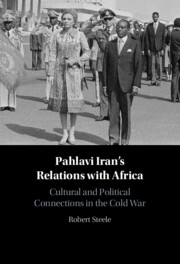Book contents
- Pahlavi Iran’s Relations with Africa
- Pahlavi Iran’s Relations with Africa
- Copyright page
- Contents
- Figures
- Acknowledgements
- Note on Transliteration
- Introduction
- Part I Establishing Relations (c. 1957–1970)
- 1 Iran, Egypt and the Spectre of Nasserism
- 2 Iran, North Africa and Islamic Solidarity
- 3 ‘Creating Influence and Dialogue with the African Continent’ (1960–1968)
- 4 Establishing Ties with Apartheid South Africa
- Part II Forming an Africa Policy (1971–1975)
- Part III Africa and Pahlavi Iran’s Grand Strategy (1976–1979)
- Conclusion
- References
- Index
3 - ‘Creating Influence and Dialogue with the African Continent’ (1960–1968)
from Part I - Establishing Relations (c. 1957–1970)
Published online by Cambridge University Press: aN Invalid Date NaN
- Pahlavi Iran’s Relations with Africa
- Pahlavi Iran’s Relations with Africa
- Copyright page
- Contents
- Figures
- Acknowledgements
- Note on Transliteration
- Introduction
- Part I Establishing Relations (c. 1957–1970)
- 1 Iran, Egypt and the Spectre of Nasserism
- 2 Iran, North Africa and Islamic Solidarity
- 3 ‘Creating Influence and Dialogue with the African Continent’ (1960–1968)
- 4 Establishing Ties with Apartheid South Africa
- Part II Forming an Africa Policy (1971–1975)
- Part III Africa and Pahlavi Iran’s Grand Strategy (1976–1979)
- Conclusion
- References
- Index
Summary
In his search for allies who would help him challenge Nasserism and other radical movements, the shah found a companion in the emperor of Ethiopia, Haile Selassie I. This chapter investigates the early years of this relationship and some of the issues that prompted the two sides to cooperate – including common security concerns in the Red Sea, threats to the global monarchical institution, and the challenges that decolonisation presented to conservative regimes in the Global South. Ethiopia provided Iran with its first ally in sub-Saharan Africa, but it was not until the Summit Conference of Independent African States in Addis Ababa in 1963 that Iran began seriously to consider its future role in Africa. Several emissaries from Africa had already visited Iran, for example from Nigeria and Cameroon, and in 1964, a report was published by the Imperial Court on the opportunities Africa could present to Iran. Subsequently, the decision was taken to deepen ties with the continent as a matter of urgency. Because Addis Ababa was the de facto diplomatic capital of Africa, it was perceived as a bridge to the rest of Africa.
Keywords
- Type
- Chapter
- Information
- Pahlavi Iran's Relations with AfricaCultural and Political Connections in the Cold War, pp. 65 - 93Publisher: Cambridge University PressPrint publication year: 2024



